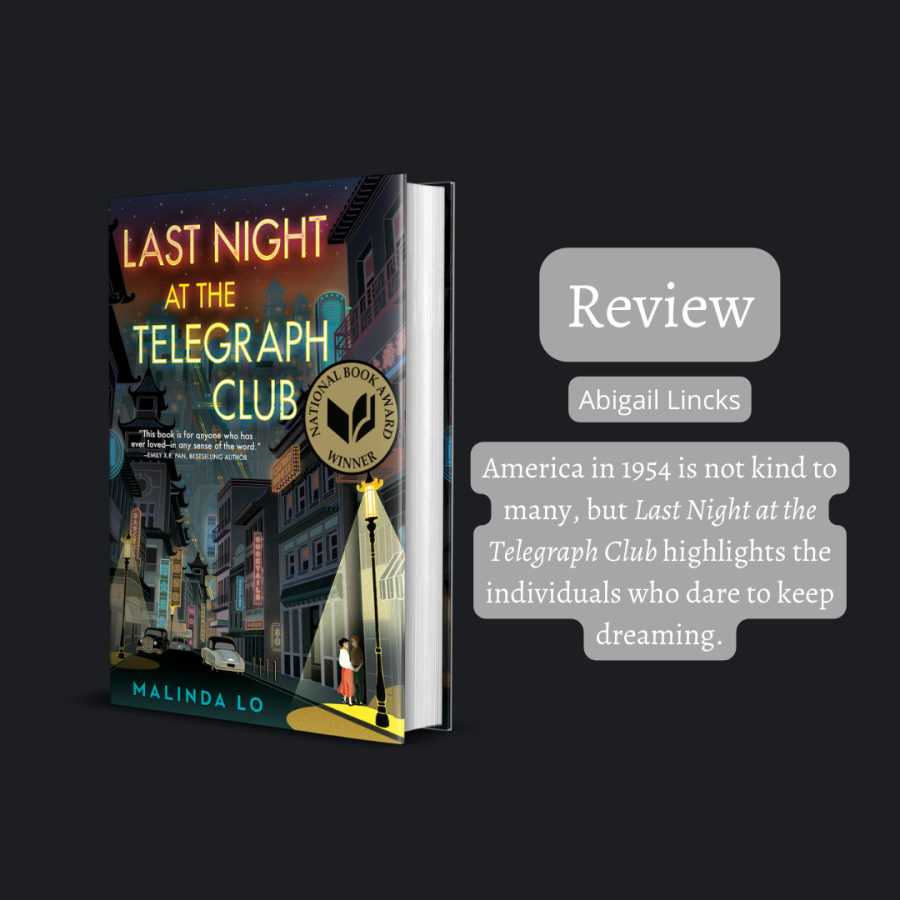“Last Night at the Telegraph Club” book review
Published in January of 2021, “Last Night at the Telegraph Club,” is a historical fiction romance novel in 1954 America.
February 10, 2022
Red Scare paranoia is rising, and deportation is a threat to everyone around. After Lily’s father is accused of defending and hiding the identity of a communist, his citizenship papers are taken away. Even Chinese Americans like Lily are at risk, leaving her family in a standstill of fear. America in 1954 is not kind to many, but Last Night At The Telegraph Club highlights the individuals who dare to keep dreaming.
Author Malinda Lo includes a helpful timeline, interspersed through four different sections of the book. Including actual events like, Japan invades Manchuria (1931) and the Chinese Exclusion Act is repealed (1943) with fictional events pertaining to the plot. This makes Last Night at the Telegraph Club an excellent introduction to Chinatown in 1954 San Francisco, especially to inexperienced readers.
In the back of this community’s mind, Red Scare paranoia, deportation and prejudice are a major threat. But they go forward with their lives as American citizens and support each other through a strong sense of community. In descriptions of food prepared and passed around the Hu family table, like nien-kao (New Year sweet rice cake), lo-han chai (vegetarian dish), hsün yü (Shanghai smoked fish) and pa pao fan (steamed sticky rice filled with sweet bean paste), readers can learn more about Chinese culture through the Hu family.
In addition, short flashback chapters between Lily’s parents, Grace and Joseph Hu, are present throughout the novel. This introduces a new lens different from the main perspective of Lily. Inclusion of decades past perspectives captures the generational effects Lily’s parents have had on her own life, but also for their own careers and futures amidst the end of a war, connecting the parallels and differences between parent and child.
Last Night at the Telegraph Club tackles popular perceptions of the 1950’s from stereotypes about Chinese Americans to the LGBTQ scene. Lo doesn’t shy away from terms and ideas to shield the reality of the times.
In an interview on the blog We Need Diverse Books, Lo said, “The vast majority of fiction about queer women is contemporary because until very recently, most people denied the fact that queer people even existed before modern times.”
Later, Lily befriends fellow classmate Kathleen ‘Kath’ Miller, and as the two begin to learn more about each other, a strong, special bond is formed. Both Hu and Miller find a safeplace in each other to confide over self-identity and dreams they both secretly want to obtain. Their dynamic, interesting personalities and backgrounds left me intrigued throughout, always wanting more dialogue that I wish Lo included more of.
I absolutely adored this book. It was compelling, educational and a lot of the time, it was heartwarming to read. Malinda Lo’s writing was superb and I will definitely be looking for more published works of hers. Before, I hesitated to reach for historical fiction due to the complexity of world-building within; but Last Night at the Telegraph Club has completely flipped my perspective.






